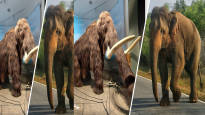A US biotech company announced that it has reached a breakthrough in a special project: the company plans to modify the Asian elephant into a “winter model”.
If everything goes as planned, a strange creature will roam the tundra in the future: an Asian elephant with a thick coat of hair, extra fat and immunity to herpes.
It would not technically be a mammoth, but a similar animal. A mammoth-like elephant could be called an emmut, for example.
The US biotechnology company Colossal Biosciences is preparing to create such an animal. The project has just achieved a significant breakthrough, claims the company’s founding member, a professor at Harvard and MIT George Church In an interview with NPR.
According to Church, the company managed to create for the first time an induced pluripotent stem cell (iPSC) from the cells of an Asian elephant, i.e. a stem cell created in the laboratory that can be used to create almost any adult cell.
A peer-reviewed article is in progress about the work to bioRxiv. According to the company, the peer review of the article is in progress.
With Asian elephant iPSCs, Church’s company aims to give the species “mammoth-like” characteristics through gene editing and cloning.
In Church’s plan, the Asian elephant would be modified so that it would grow a thick, warm coat of hair and extra layers of fat. In addition, Church plans to genetically engineer an elephant to be immune to the herpes virus, which kill elephants especially in zoos and safaris.
The critically endangered Asian elephant is one of three living elephant species. The Asian elephant is smaller and hairier than the African elephant. African elephants are the same size as perhaps the most famous species of mammoth, the woolly mammoth.
Woolly mammoths were two to four meters high at the withers. The last woolly mammoths are thought to have lived on remote islands in the direction of Alaska and Siberia 6,000–4,000 years ago.
The company justifies the mammoth creation with conservation work
Church justifies the mammoth project as a conservation work for elephants and as a research of general interest on whether the survival of the species can be helped by gene editing.
Research colleagues are not enthusiastic about the project.
Professor of Geosciences at the University of Arizona interviewed by NPR Karl Flessa thinks the project aims to “create a freak circus in zoos”. Flessa also wonders if it is worth creating fur elephants right now, when global warming will immediately drive them to another extinction.
Another researcher wonders if, instead of creating new species, it would be better to protect existing species from the ongoing mass extinction.
